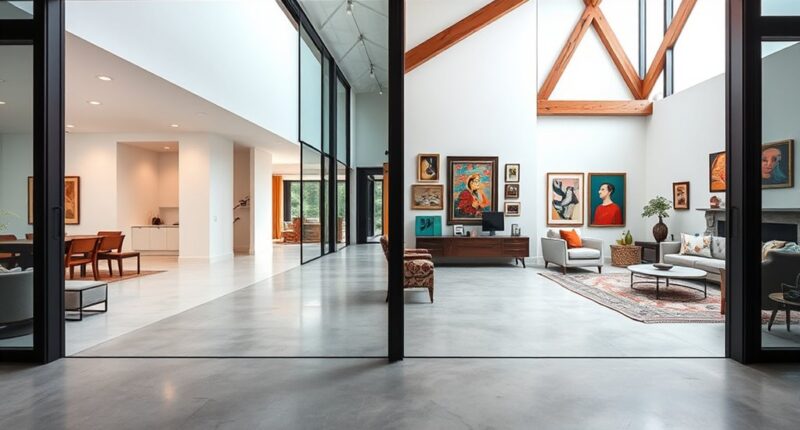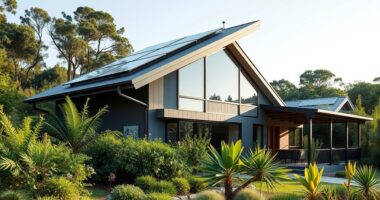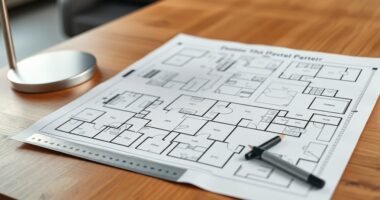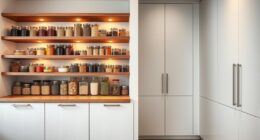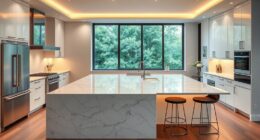Choosing between modern, traditional, or eclectic styles depends on your lifestyle and personal taste. Modern design emphasizes sleek, minimalist spaces with open layouts and eco-friendly materials. Traditional styles showcase timeless charm with detailed craftsmanship and classic elements. Eclectic combines different influences for a unique, personalized look. Consider how each style aligns with your daily routines and aesthetics. Keep exploring to learn how to craft a space that reflects your personality and meets your needs.
Key Takeaways
- Consider your personal taste: modern for sleek minimalism, traditional for classic charm, eclectic for unique, personalized spaces.
- Evaluate your lifestyle needs: functionality, comfort, and space usage influence the most suitable style choice.
- Think about maintenance and durability: modern styles favor minimal upkeep, traditional may require more care, eclectic blends various textures.
- Match your preferred materials and finishes: sleek surfaces for modern, carved wood for traditional, mixed textures for eclectic.
- Assess your budget and project scope: style complexity impacts costs; simpler designs like modern may be more budget-friendly.
Understanding Modern Architecture and Design Elements

Modern architecture emphasizes clean lines, open spaces, and functional design. You’ll notice that minimalist furniture plays a key role, emphasizing simplicity and practicality without clutter. Sustainable architecture, another hallmark, focuses on eco-friendly materials and energy efficiency, making your home environmentally conscious. The design avoids unnecessary ornamentation, favoring sleek surfaces and geometric forms. Incorporating visual cues can enhance the aesthetic appeal and functionality of modern spaces. Large windows bring in natural light, creating an airy atmosphere that enhances the open layout. The use of natural materials, like wood and stone, complements the sustainable approach.
Key Features of Traditional Home Styles

What makes traditional home styles stand out? It’s the classic charm they exude, rooted in timeless architectural details. You’ll notice symmetrical layouts, gabled roofs, and inviting porches that create a welcoming feel.
These homes often feature decorative elements like crown molding, ornate window trims, and brick or stone facades, highlighting their craftsmanship. Traditional charm also comes from balanced proportions and carefully curated details that evoke a sense of history and stability. Materials like brick and stone often contribute to their enduring appeal and sense of permanence. Additionally, the use of electric power sources can enhance the functionality and sustainability of traditional homes. Incorporating energy-efficient systems can further improve their ecological footprint and reduce long-term costs. The integration of modern technology can also support home automation features that increase convenience and security.
You’ll appreciate the attention to detail in features like columns, shutters, and intricate woodwork. Additionally, many traditional homes incorporate internal company hackathons to inspire innovative design solutions and enhance team collaboration, enriching the overall aesthetic and functionality. Overall, these architectural details give traditional homes a warm, enduring appeal that feels both familiar and sophisticated.
The Appeal of Eclectic and Mixed Design Approaches
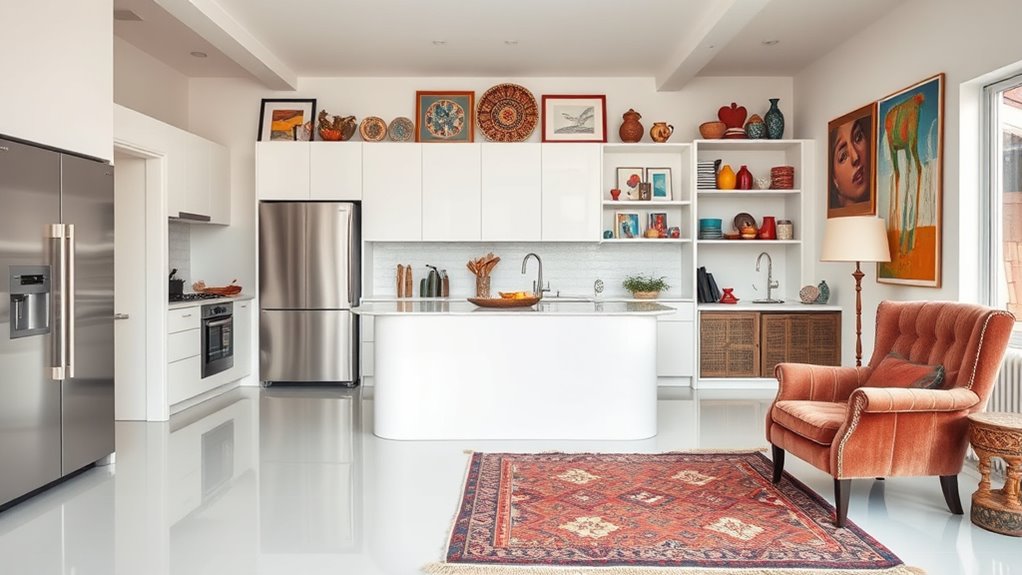
Eclectic and mixed design approaches let you showcase your personality through unique personal expressions. They offer the flexibility to combine different styles and create a versatile aesthetic that reflects your tastes. Incorporating textile art techniques can further enhance your space by adding texture, color, and visual interest. This approach keeps your space fresh, interesting, and truly yours, especially when considering retail hours to discover new materials and inspiration. Being aware of ice cream flavors and trends can also inspire playful and colorful accents within your decor, making your space more inviting and personalized. Additionally, understanding entertainment support hours can help plan visits to local attractions that may influence your decor themes or provide inspiration for fun, dynamic spaces. Exploring keto diet tracking methods and integrating dietary themes can also add a unique, health-conscious dimension to your interior storytelling.
Unique Personal Expressions
Have you ever wondered why mixing different styles feels so appealing? It’s because eclectic design lets you express your personality uniquely. You can blend vintage finds with modern furniture or incorporate DIY trends to add a personal touch. Using sustainable materials shows your commitment to eco-friendly choices while giving your space character. This approach encourages creativity, making your home a reflection of your journey and values. Imagine a cozy corner with colorful textiles, repurposed furniture, and handcrafted decor—each piece telling a story. Here’s a quick visual:
| Vintage Finds | Modern Touches | Handmade Items |
|---|---|---|
| Reclaimed wood | Sleek metals | Knitted throws |
| Antique lamps | Minimalist art | Macramé hangings |
| Upcycled furniture | Statement art | Customized accessories |
Incorporating regional design influences can further personalize your eclectic style to reflect local culture and environment. Additionally, understanding the history of design movements can inspire your unique blend of styles. Recognizing the personal expression aspect of eclectic design can also help you create a space that truly resonates with your identity. Exploring driving techniques for bike maintenance can inspire a sense of craftsmanship and attention to detail, much like curating a personalized space. Incorporating sustainable materials not only benefits the environment but also adds authenticity and depth to your design.
Versatile Aesthetic Combinations
Mixing different design styles can create a dynamic and personalized space that reflects your unique taste. Eclectic and mixed approaches allow you to experiment with diverse color palettes, blending bold and neutral shades for visual interest. By combining vintage furniture with modern accents, you craft a layered look that feels both fresh and familiar. Lighting design plays a vital role here; strategic use of ambient, task, and accent lighting highlights your eclectic choices and enhances the overall ambiance. Incorporating natural materials such as wood and linen can further unify diverse styles and add warmth to your space. Additionally, understanding GMC tuning techniques can inspire creative modifications that mirror your personalized aesthetic in automotive customization. This versatile approach lets you balance contrasting elements, making your space truly one-of-a-kind. Embrace the freedom to mix textures, patterns, and eras, creating a lively environment that showcases your personality and creativity. Incorporating design principles can help you achieve harmony amidst variety, ensuring your eclectic space remains cohesive and inviting.
Materials and Finishes That Define Each Style
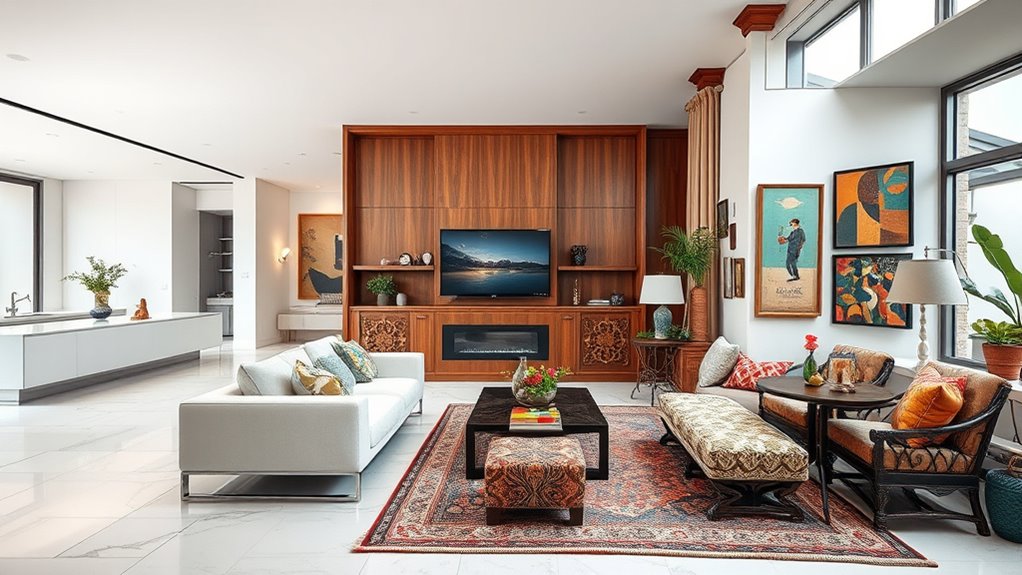
The materials and finishes you choose play a crucial role in defining each style, setting the tone and character of a space. For modern designs, sleek surfaces like glass, metal, and polished concrete create a clean look. Incorporating high-quality projectors with sharp, detailed images can enhance the contemporary feel of a modern space. Utilizing innovative finishing techniques can also add texture and depth to these surfaces, elevating the overall aesthetic. When selecting furniture choices, consider the finishes—smooth lacquer for modern, carved wood for traditional, or mixed materials for eclectic. Lighting fixtures also reinforce the style: minimalist LEDs suit modern interiors, vintage chandeliers suit traditional, and eclectic spaces often feature bold, statement pieces. Your choices in materials and finishes craft the visual narrative that defines each style. Additionally, understanding the seasonal variations can influence the selection of durable and adaptable finishes suitable for different climates. Incorporating versatile materials that complement hybrid bikes can also inspire cohesive design choices that reflect both functionality and style. Recognizing the psychological impact of different finishes can further refine your selections to create desired moods and atmospheres within each style.
Customizing Your Space to Suit Your Lifestyle
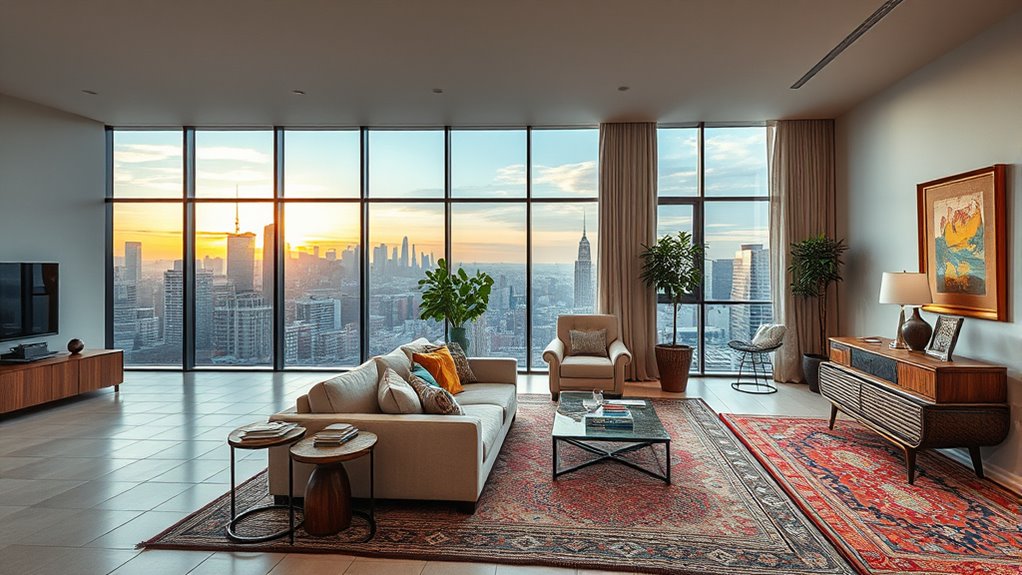
Once you’ve selected materials and finishes that reflect your desired style, the next step is tailoring your space to fit the way you live. Focus on furniture placement to maximize functionality and comfort, arranging pieces so your daily routines flow naturally. Consider how you use each room—whether it’s for relaxing, working, or entertaining—and position furniture accordingly.
Lighting design also plays a vital role; incorporate layered lighting with a mix of ambient, task, and accent lights to create the right mood and highlight your style. Use natural light where possible, and add fixtures that complement your overall aesthetic.
Maintenance and Upkeep Considerations for Different Styles
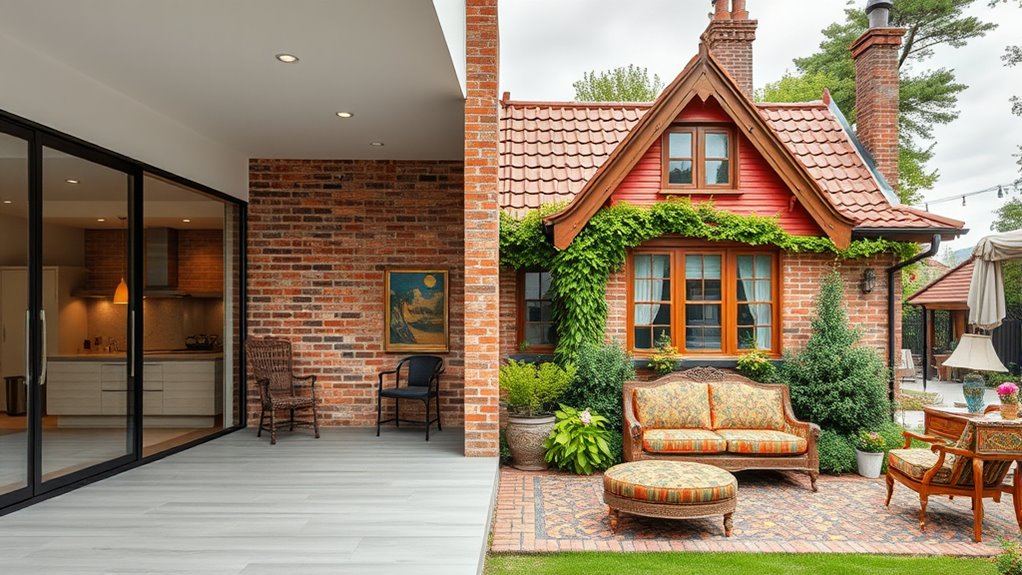
Choosing a style for your space means considering how much maintenance it will require over time. Modern designs often focus on clean lines and minimal upkeep, making landscape integration and energy efficiency easier to manage.
Traditional styles may demand more ongoing care, especially with detailed moldings and classic materials. Eclectic styles balance diverse elements but may require extra attention to maintain their aesthetic.
To keep your space in top shape:
- Regularly inspect and maintain landscape features to prevent overgrowth or damage.
- Choose energy-efficient materials suited to your style to reduce ongoing costs.
- Schedule routine cleaning and repairs tailored to your design’s specific elements, whether it’s sleek surfaces or intricate details.
Understanding these factors helps guarantee your style remains attractive and functional with manageable upkeep.
How to Incorporate Personal Touches Without Compromising Style
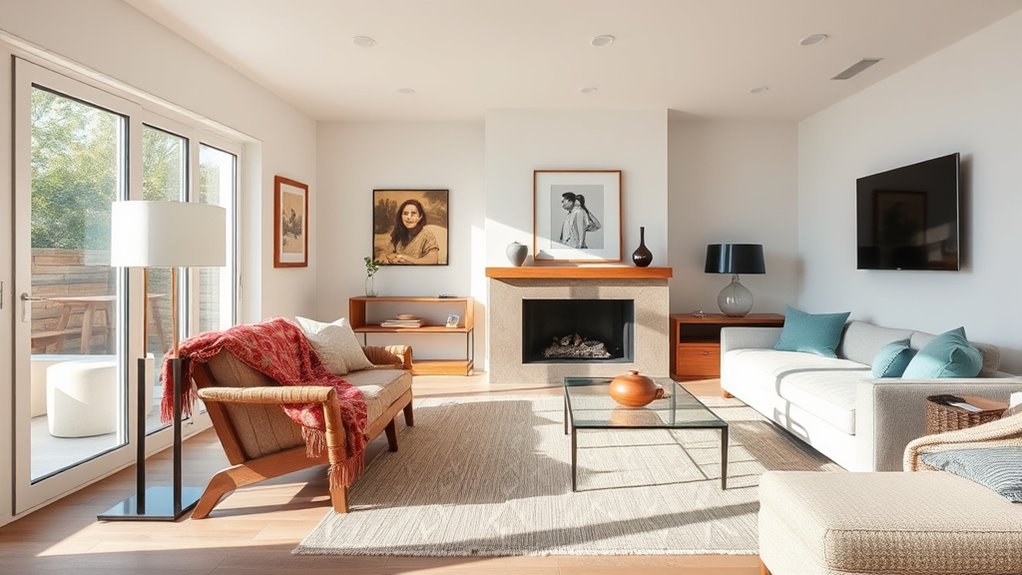
Incorporating personal touches into your space can enhance its uniqueness without compromising your chosen style. To do this, select personal decor that complements your overall design, ensuring it adds character without cluttering. Art and accessories are perfect for showcasing your personality while maintaining style cohesion.
For a modern look, choose sleek, minimalist pieces that reflect your interests. For traditional spaces, opt for timeless artwork and vintage accessories. Eclectic designs thrive on mixing personal decor with a curated collection of art and accessories that tell your story.
Keep balance in mind: place statement pieces thoughtfully, and avoid overwhelming the space. Thoughtful integration of personal touches allows your home to feel authentic and inviting, all while respecting your style’s aesthetic.
Balancing Functionality and Aesthetics in Your Build
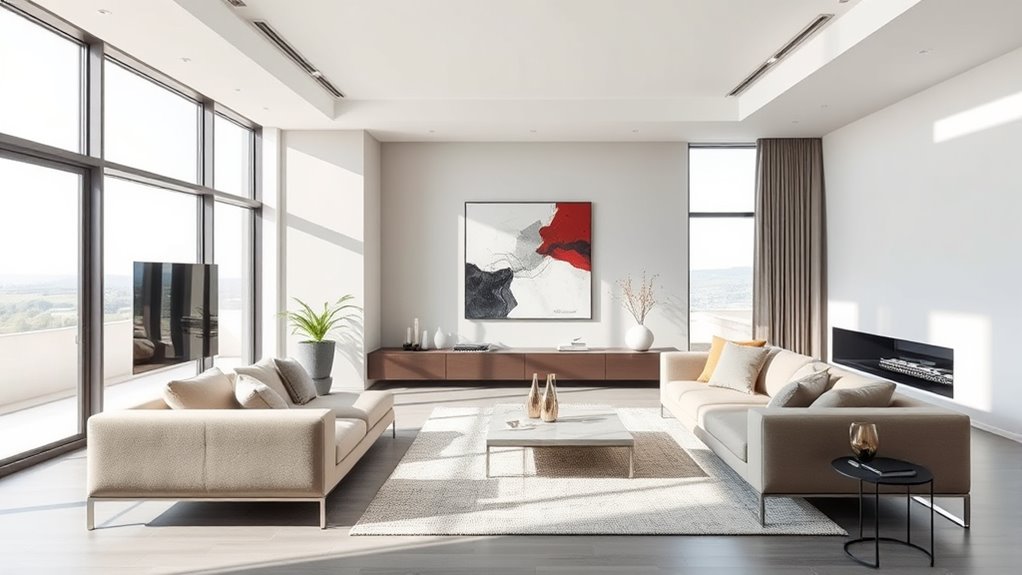
You need to find a way to make your space both practical and stylish. Prioritizing how you use each area helps keep things functional without sacrificing looks.
When you balance style and comfort, your build feels both inviting and efficient.
Prioritizing Practical Space Use
Balancing functionality and aesthetics is vital when prioritizing practical space use in your build. You need to optimize furniture placement to guarantee each area feels open yet functional. Proper furniture positioning allows for easy movement and maximizes storage.
Lighting choices also play a significant role, helping define zones and create a welcoming atmosphere. Consider these steps:
- Arrange furniture to promote flow, avoiding cluttered pathways.
- Use lighting to highlight key spaces and improve usability.
- Select multi-purpose furniture that offers storage without sacrificing style.
Harmonizing Style and Comfort
Achieving harmony between style and comfort requires thoughtful choices that enhance both visual appeal and livability. Start by selecting interior color schemes that complement your overall design, creating a cohesive look that feels inviting.
Balance aesthetics with functionality by choosing furniture and layouts that prioritize comfort without sacrificing style. Don’t forget outdoor landscaping—well-designed outdoor spaces extend your interior’s vibe and provide a relaxing environment.
Incorporate natural elements and strategic plantings to soften the look and add visual interest. When style and comfort align, your home becomes a sanctuary you love to live in.
Focus on seamless progressions between indoor and outdoor areas, ensuring each space supports your lifestyle while maintaining aesthetic harmony. This balance makes your build both beautiful and practical.
Tips for Visualizing and Planning Your Ideal Home Style
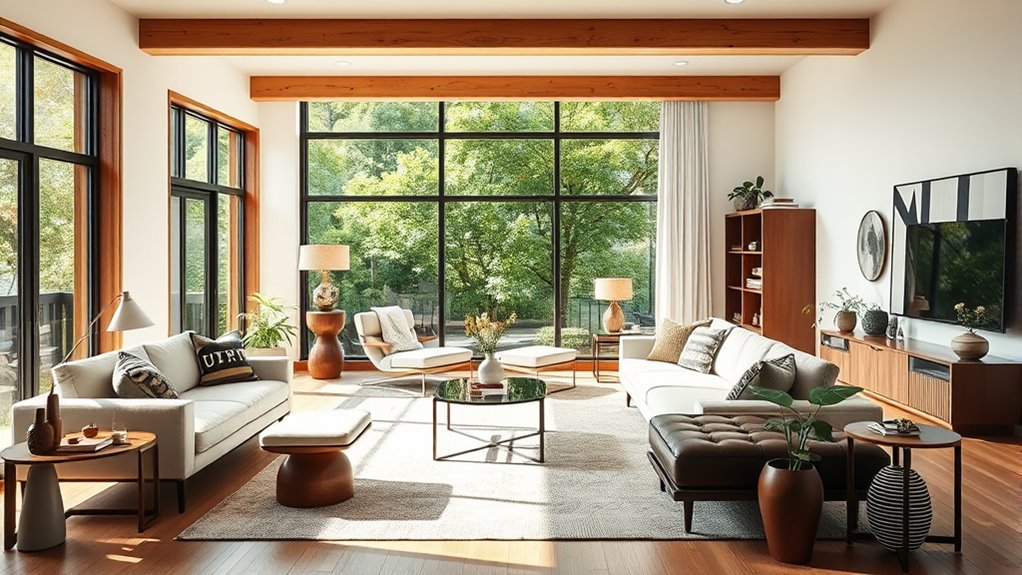
Visualizing your ideal home style begins with gathering inspiration from various sources. Create a mood board or digital collection to identify recurring themes, colors, and textures.
Start by collecting inspiration from various sources to identify your home’s recurring themes, colors, and textures.
Next, focus on your floor plan, ensuring it aligns with your desired style and lifestyle. Consider how spaces flow and connect, emphasizing open layouts for modern designs or defined rooms for traditional styles.
Don’t forget lighting design—think about natural light and fixture choices that enhance your chosen aesthetic.
To refine your vision, try these steps:
- Pinpoint key elements like furniture, finishes, and accessories that match your style.
- Sketch or use digital tools to experiment with different layouts and lighting schemes.
- Visit showrooms or model homes to see real-world examples and gain perspective.
Frequently Asked Questions
How Do I Choose a Style That Fits My Climate?
To select a style that fits your climate, focus on climate adaptation and style compatibility. Consider materials that withstand local weather, like insulation for cold areas or breezeways for hot climates.
Think about how your chosen style responds to your environment’s conditions. You’ll want a design that naturally adapts, keeping your space comfortable and energy-efficient.
Ultimately, selecting a style that aligns with your climate guarantees both beauty and practicality in your home.
Can I Combine Elements From Different Home Styles?
You can absolutely mix styles to create a unique, personalized home. When combining elements from different design styles, focus on maintaining design harmony by balancing colors, textures, and architectural features.
Think about how each element complements the others, avoiding clutter or conflicting styles. Experiment with mixing styles intentionally, and don’t be afraid to trust your instincts.
This approach helps craft a space that reflects your personality while feeling cohesive and stylish.
What Are Cost Differences Among Modern, Traditional, and Eclectic Designs?
When comparing costs, modern designs often have a higher budget due to sleek materials and innovative features.
Traditional styles can be more affordable with classic finishes. Eclectic designs may vary, blending costs based on chosen elements.
For your budget planning, consider that modern styles might require more investment, whereas traditional options could save money.
Understanding these cost differences helps you select a style that fits your financial plans.
How Does Neighborhood Context Influence My Style Choice?
Think of your neighborhood as a tapestry, woven with its unique identity and local architecture. You’ll want your style to complement this fabric, blending seamlessly or standing out intentionally.
If your neighborhood boasts classic, traditional homes, a traditional or eclectic design might feel right. Conversely, a modern style can elevate a contemporary vibe.
Your choice should honor and enhance the neighborhood’s character, making your home a natural part of its story.
What Are Common Pitfalls When Selecting a Home Style?
When choosing your home style, watch out for common pitfalls like sacrificing style consistency and architectural harmony. You might be tempted to mix too many elements or ignore the neighborhood’s vibe, which can make your home feel out of place.
To avoid this, focus on creating a cohesive look that complements the surroundings and maintains harmony throughout your design. Ensuring your home feels integrated and well-balanced is key to a successful style choice.
Conclusion
Choosing your home style is like steering a ship through a vast sea—each wave, whether modern, traditional, or eclectic, guides your journey. Trust your compass, listen to your heart’s call, and embrace the adventure. Your perfect home isn’t just a destination but a voyage of self-expression. Set sail with confidence, knowing that every choice shapes your unique harbor—your sanctuary where style and soul unite in harmony.
